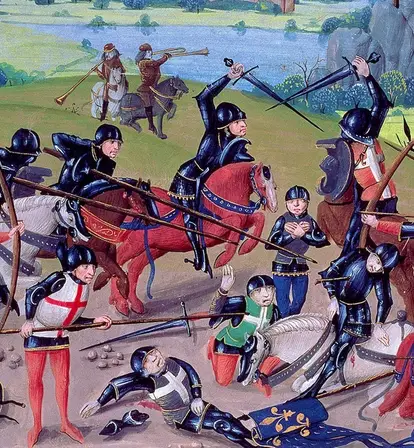England's army of archers and men-at-arms killed somewhere between 4,000 and 10,000 French soldiers at the Battle of Agincourt, after rain and heavy armor forced the French to literally sink into the battlefield.
If the timeless phrase “band of brothers” calls up romantic images of unity and camaraderie on the battlefield, you have the Battle of Agincourt to thank. Or popular representations of it, anyway.
The Battle of Agincourt of 1415 is one of the most legendary military victories in English history, owing much of its fame to its centrality in Shakespeare’s 1599 play Henry V, which mythologized the battle and its victor, King Henry V of England.
Shakespeare’s climactic rendition of the battle shaped its historical legacy and inspired countless literary and film renditions since — most recently Netflix’s The King.
But what was the 15th-century battle really like? Read on for the truth behind the titillating tales of Shakespearean legend that still shape our view of history today.
The Hundred Years’ War
First, it is important to understand the Battle of Agincourt’s place in the Hundred Years’ War, a generations-long tug-of-war between England and France over the succession to the French throne and ownership of Gallic territory.
The war stretched from 1337 to 1453, but tension between the French and the English dates back to at least 1066, the year that William the Conqueror, a French duke, invaded England and declared himself its king.
Over the next few centuries, continuous inbreeding between French and English royalty meant that English monarchs continuously laid claim to the French throne. That’s what happened when Philip of Valois became king of France in 1328 over England’s Edward III. Edward’s link to the throne came through his mother instead of a male heir, and so he was denied the right to lead France.
His claim to the French throne became the impetus for a 116-year-long conflict between the two kingdoms.

Bibliothèque de Genève/Wikimedia CommonsKing Charles VI of France, who was plagued with mental illness throughout the end of his rein.
Over the next century, France fought to weaken England’s hold on their continental lands, and by the 15th century, much of the French land that was once in the possession of the English Plantagenet family had been lost. The fighting had largely ceased, and a truce was declared in 1396.
At the time our story begins, in the years leading up to the Battle of Agincourt in 1415, England was ruled by the young Henry V, who demonstrated his strength in holding onto his crown.
Meanwhile, France was ruled by Charles VI of the Valois house, a man whose tragic bouts of mental illness, during which he killed four of his own knights and thought he was made of glass, rendered his leadership ineffectual; countless dukes and princes and consorts battled for control of the French government.
Meanwhile, two political factions — the Burgundians, who supported the Duke of Burgundy, and the Armagnacs, who back the Duke of Orléans — had been duking it out in northern France since 1407.
Ripped apart by domestic conflict, France was vulnerable to invasion.
The Road To Battle
In Shakespeare’s plays, young King Henry V is a completely transformed man when he assumes the English throne, casting aside his reckless youth and building a new reputation as a wise, war-savvy king.
The play opens as a proud Henry is taunted into battle by the French Dauphin Louis, who sends him a barrel of tennis balls to mock his lack of maturity.
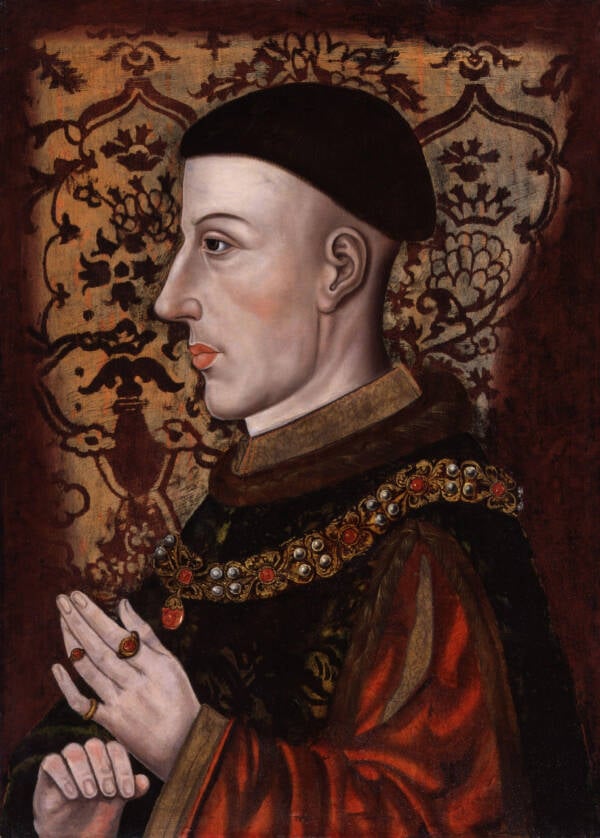
National Portrait Gallery/Wikimedia CommonsKing Henry V of England, late 16th or early 17th century.
In Netflix’s The King, Timothée Chalamet’s King Henry also demonstrates more of an interest in parties than politics as a teenager, but in a departure from Shakespearean legend, the new king is angsty, idealistic, and a pacifist.
He resists both the provocation of the Dauphin (played by an eccentric and thickly French-accented Robert Pattinson) and a supposed French-sponsored assassination attempt on his life. He wants to create a “peaceful air” for his people to breath, and it is only due to the incessant pressure of his advisors and the will of his people that he reluctantly agrees to go to war.
In reality, from the moment he was crowned king, the historical Henry V set his eyes on the continent, eager to pursue a campaign of military conquests in France.
Soon after his coronation in 1413, he presented France with a lofty list of demands: He wanted King Charles VI to return land that had belonged to his ancestors, such as Aquitaine and Normandy; he wanted 2 million crowns; and he wanted to maneuver his way into the French line of succession by marrying the king’s daughter, Catherine of Valois.
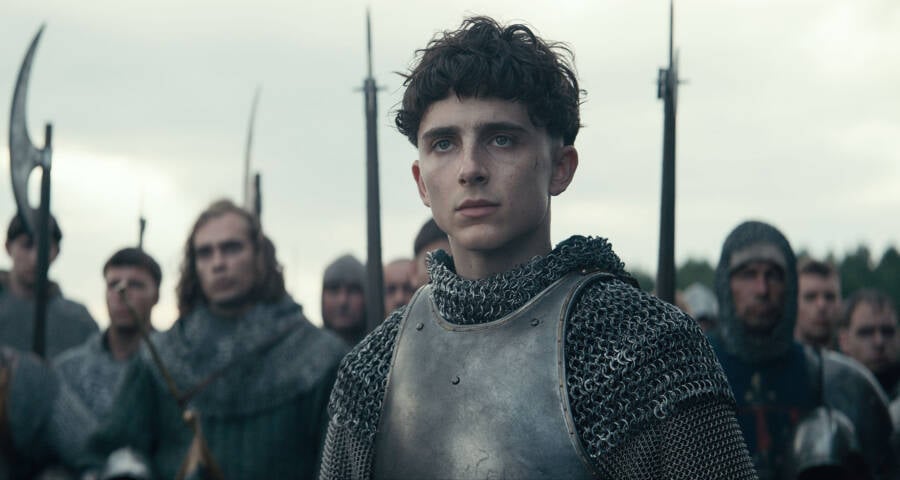
NetflixTimothée Chalamet plays King Henry V of England in The King.
He set sail for France from Southampton in mid-August 1415, with an army of a about 12,000 — the largest English army in a century. Three days later, his troops arrived on the northern French coast and laid siege to the port of Harfleur in Normandy.
According to Shakespeare, Henry V rallied his troops to follow him “once more upon the breach, dear friends.” This moving speech, which became legendary and forever associated with Henry V, was probably made up by Shakespeare. Interestingly, it was not included in The King.
The French held their own at Harfleur for more than a month, surprising Henry with their resiliency, but the town fell at last on September 22. Though victorious, Henry’s army dwindled due to armed conflict, desertions, and bouts of dysentery.
Some historians estimate that 1,330 soldiers had to return home and 37 died, while other sources suggest he lost as many as half his men to disease and battle casualties.
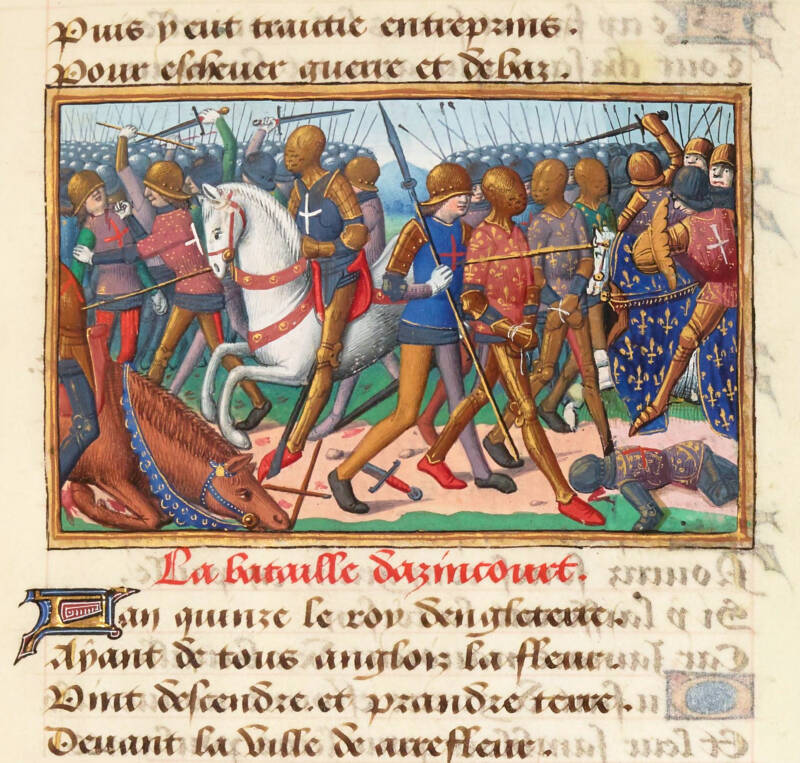
Wikimedia CommonsA depiction of the Battle of Agincourt from the 1490s.
Harfleur was now under the control of about 1,200 English soldiers. Its governance was in the hands of English officials, and the French residents were expelled from their homes.
On October 5, Henry and his battered and exhausted army of only 6,000 began marching east, hoping to sail back to England and regroup. Instead of attacking Paris next, as planned, they headed toward the port of Calais, where they would meet with the English fleet and return home to England.
But a French army followed them and tried to block their route and force them into a confrontation. The English managed to avoid them for a few weeks but by October 19 they were confronted by a vast army of approximately 20,000 French soldiers near the village of Azincourt (which the English later anglicized to Agincourt), just 40 miles south of Calais.
The next day, French heralds arrived to inform Henry that the French army would be intercepting them, taking revenge for his siege of Harfleur.
The Battle Of Agincourt
While The King puts Pattinson’s comical Dauphin Louis directly on the battlefield in opposition to his rival, the brave and sombre young King Henry V, in reality, the French prince was absent from the battlefield.

British Library/Wikimedia CommonsThe dauphin Louis of France, son of King Charles VI.
The French army was instead led by Boucicaut, the marshal of France, and Charles D’Albret, France’s constable.
The legend goes that when the English arrived, they were faced with an army that vastly outnumbered them; their odds of victory were slim.
According to a contemporaneous chronicle, the English watched in horror as the “grim ranks of Frenchmen” emerged in “incomparable number in relation to us…filling a very broad field, as if they were an innumerable multitude of locusts.”
Older estimates suggested that the French had 50,000 soldiers while the English had 5,000. But more recent studies have challenged that age-old consensus, suggesting that the battle may have been a more even fight, perhaps two to one. The odds may have been exaggerated in order to bolster England’s self-image.
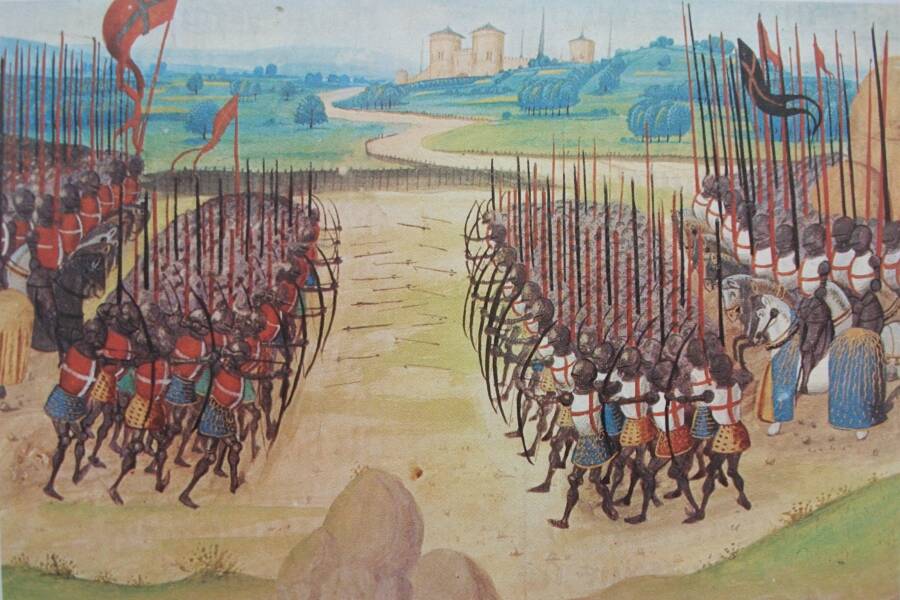
Wikimedia Commons An early 15th-century miniature of the Battle of Agincourt.
Nevertheless, regardless of the exact numbers, the English were outnumbered. Yet Henry was confident that they had God on their side (he heard mass three times on the eve of the battle). Henry insisted that with “his omnipotence” these “humble few can overcome the pride of the French that opposes him, who boast of their great number and strength.”
The starving, exhausted, and terrified English soldiers spent the night before the big battle sleeping on the field under the pouring rain.
The Battle Begins
The King credits Henry V’s longtime friend Sir John Falstaff with devising a plan to lure the French into a muddy field and shoot them from afar with archers.
In reality, Falstaff never existed — Shakespeare made him up as a foil for the king. Instead, war-savvy Henry V led his army into battle, positioning groups of archers on each side of his three groups of men-at-arms.
He was only 29 years old, but he’d already had well over a decade of experience on the battlefield; he spent much of his teenage years staving off rebellions in England and Wales on his father’s behalf.
It is at this point that, according to Shakespeare’s play, Henry urged his men into battle, affectionately referring to them as his “band of brothers.”
This dramatized speech has long been one of the most famous speeches in history. It was further immortalized when Laurence Olivier used it to raise British morale during World War II and when Kenneth Branagh recited it in his 1989 film rendition of Henry V.
Interestingly, popular medieval historian Dan Jones writes that the tone that the Shakespearean Henry uses in the play matches the grandeur of the tone that the real Henry used in the letters he dictated from the frontlines. Therefore, while the speeches themselves were not based in historical fact, the spirit of them was.
After both sides stood their ground for three years, in the hopes of maintaining their defensive barriers, the English became the first to charge. Their longbows had a spectacular range, wounding at 400 yards and killing at 200.
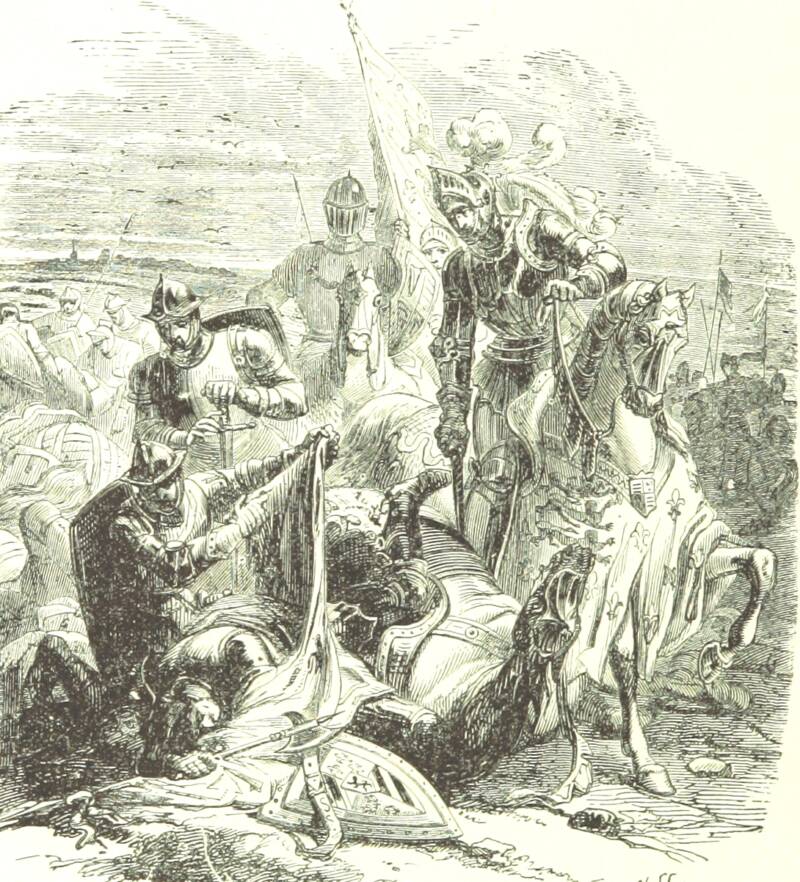
British Library/Wikimedia CommonsAn illustration from 1885 showing the Battle of Agincourt.
As depicted in The King‘s epic final battle scene, the field of Agincourt became turned into a sea of mud, with armed men crowded together so tightly they had no room to lift their arms or wield their swords.
The French cavalry were decimated as they charged forward to meet the English, arrows stabbing their necks, eyes, armpits, and groins through gaps in their heavy armor. French soldiers, weighed down by that armor, were knee-deep in mud. Some got stuck and tripped their comrades, while others suffocated and drowned beneath one another.
When English archers ran out of arrows, they charged forward using mallets, swords, and axes as weapons and killed their French counterparts at point-blank range.
According to an eyewitness account, “it seemed…that the English had never attacked their enemy more bravely, intrepidly or wilfully [sic]….Nor,” remarking on France’s poor showing, “had it ever been seen before…that so many most chosen and strong soldiers had put up resistance so sluggishly, so disorderly and fearfully or in so unmanly a fashion.”
The French lost somewhere between 4,000 and 10,000 men — all in one day.
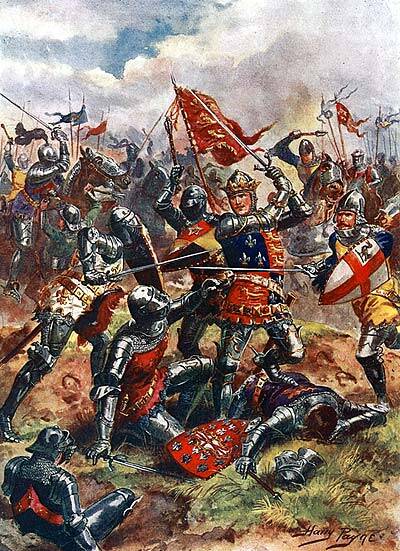
Wikimedia CommonsA 1915 painting of King Henry V at the Battle of Agincourt. He wears the Royal Arms of England on his surcoat, quartered with the Fleur de Lys of France as a symbol of his claim to the French throne.
Seemingly against all odds, the English defeated the massive French forces with minimal loss of life due to a clever military strategy, the innovative longbow, and the luck of the weather.
But it wasn’t over yet. After the fighting ended, Henry ordered the slaughter of thousands of French prisoners — a vicious act that a collection of jurists headed by Justice Ruth Bader Ginsburg ruled a war crime in a 2010 mock trial.
The Aftermath And Legacy Of The Battle Of Agincourt
The Battle of Agincourt became a touchstone of English patriotism indivisible from the name of Henry V. On November 23, he returned to London in triumph, and the play The Famous Victories of Henry V cemented his win in England’s historical canon.

Wikimedia CommonsA painting dated before 1494 showing the marriage ceremony of Henry V of England and Catherine of Valois.
Shakespeare further immortalized the battle, using it to end his play on a climactic note. He makes it seem as though the battle of 1415 spelled the end of France, and the play ends with the betrothal of Henry to Catherine of Valois.
And while The King departs from the Shakespearean tradition of glorifying war, instead depicting it in all its grim sobriety, Netflix’s film also ends on a high note with the Battle of Agincourt, making it seem as though this battle forced France to surrender and brought about Henry’s marriage to Catherine, played by Lily-Rose Depp.
But the Battle of Agincourt wasn’t the end of the story. For several more years, Henry V led military campaigns on the European continent.
The historical Henry returned to France soon after his victory at Agincourt. It was only in 1420 that the French surrendered and signed the Treaty of Troyes, officially betrothing Henry to Catherine and naming him as the heir to the French kingdom.
Two years later, after a brutal winter siege on the French city of Meaux, Henry V succumbed to illness — mere months before he would have inherited the French throne.
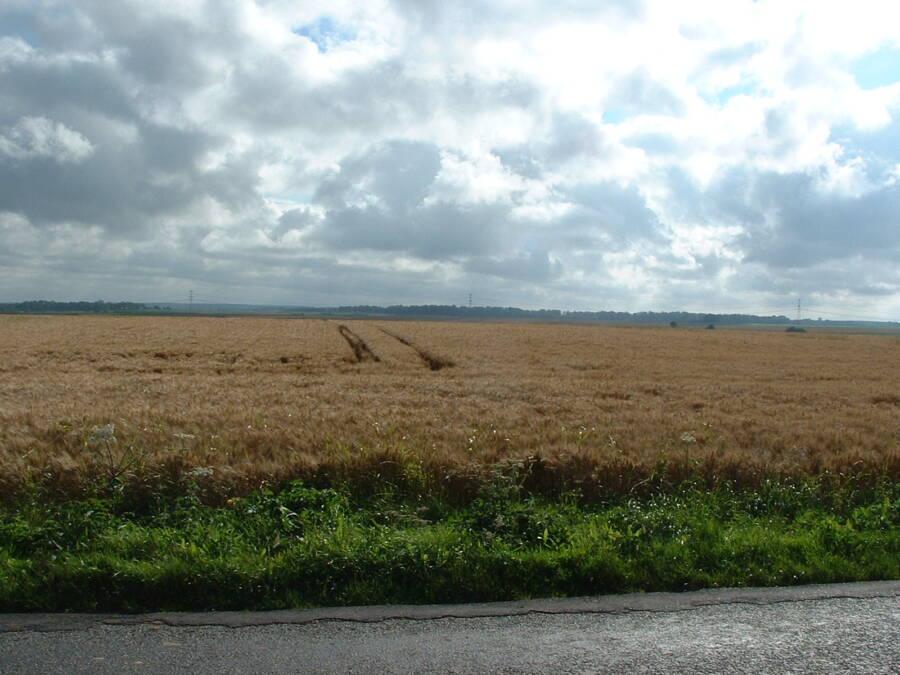
Wikimedia CommonsThe British annihilated the French on a field near the village of Azincourt (above), later anglicized to Agincourt.
Now that you have learned about the Battle of Agincourt, delve into the sham trial and gruesome death of Joan of Arc, a victim of the Hundred Years’ War. Then read all about the Battle of Bosworth Field, the epic finale to England’s decade-long civil war.
